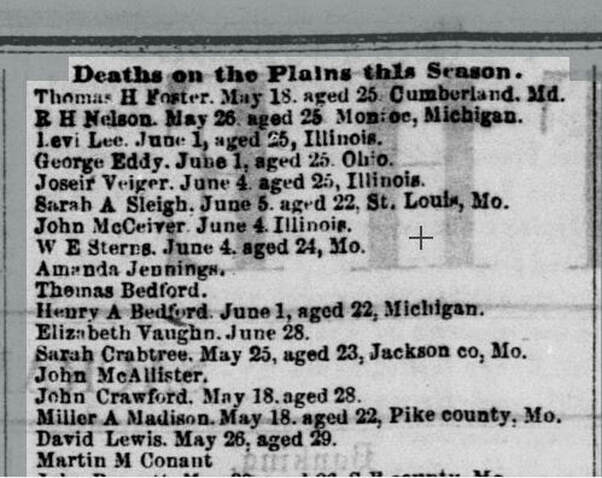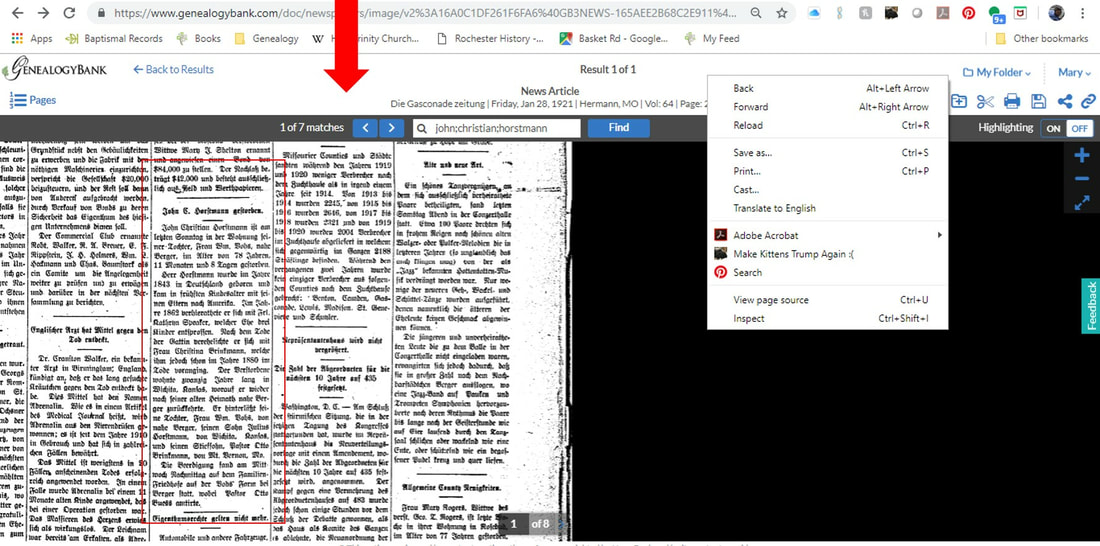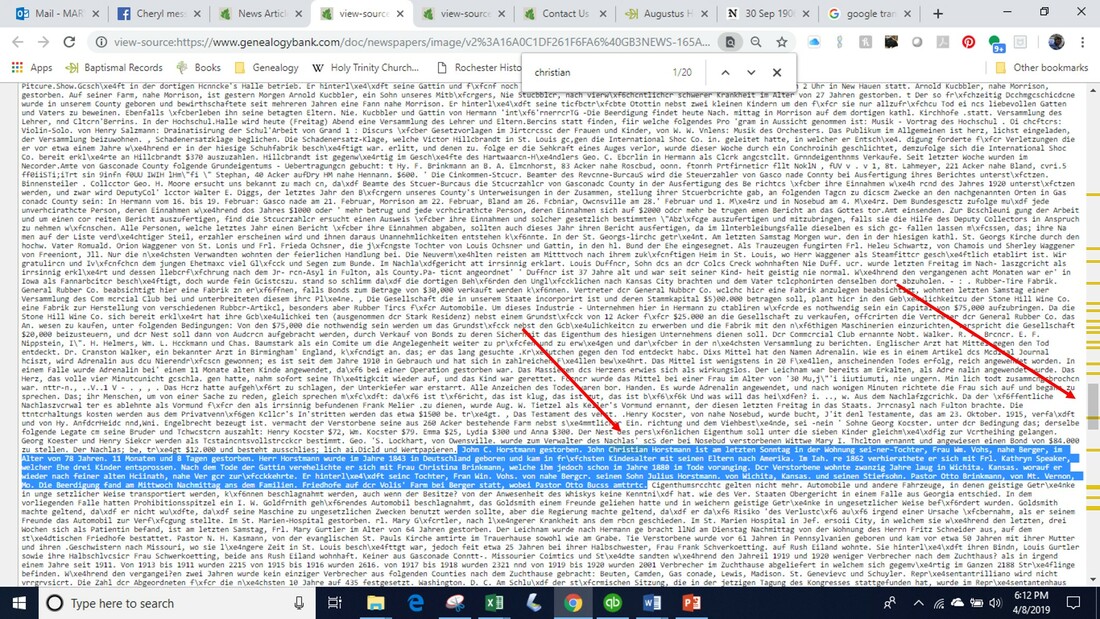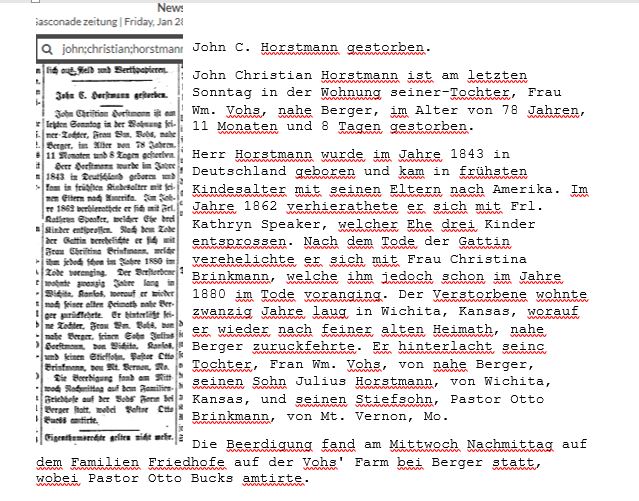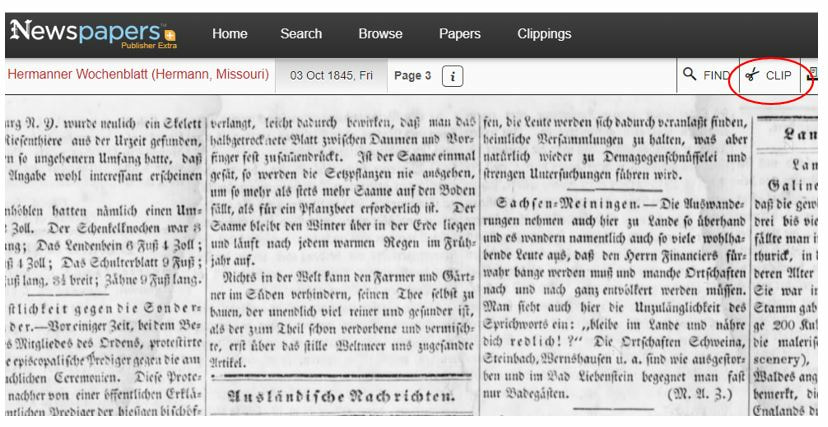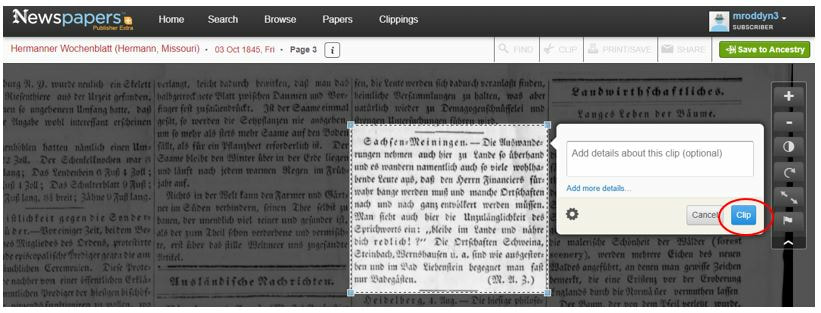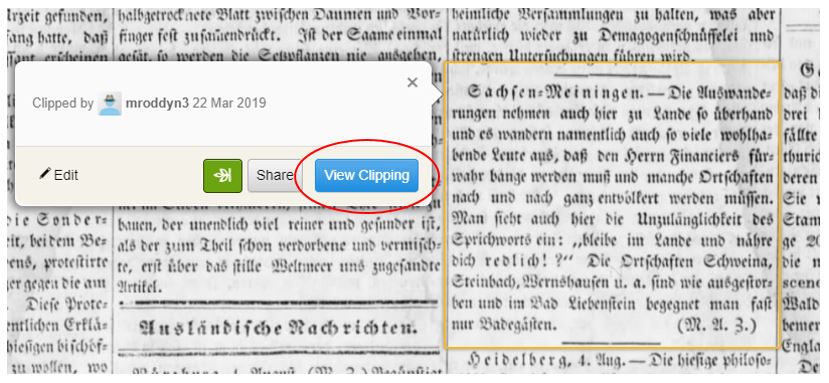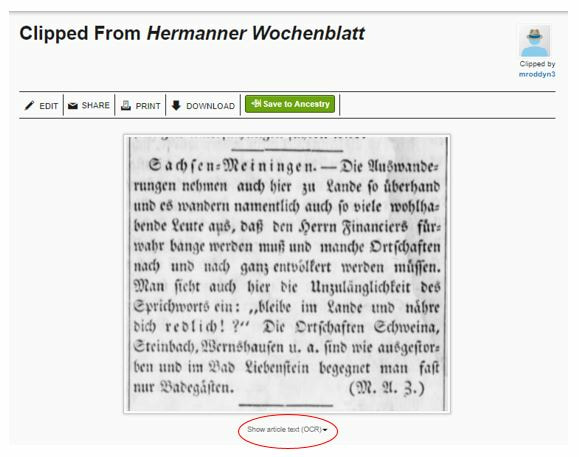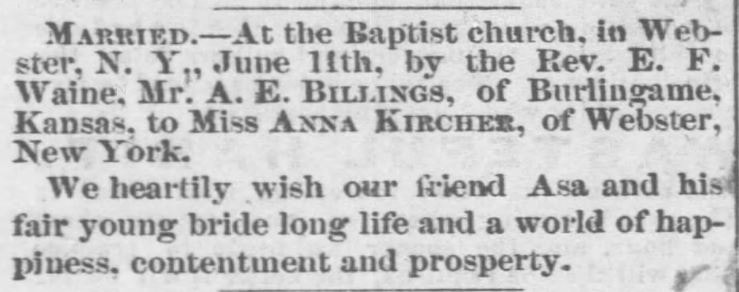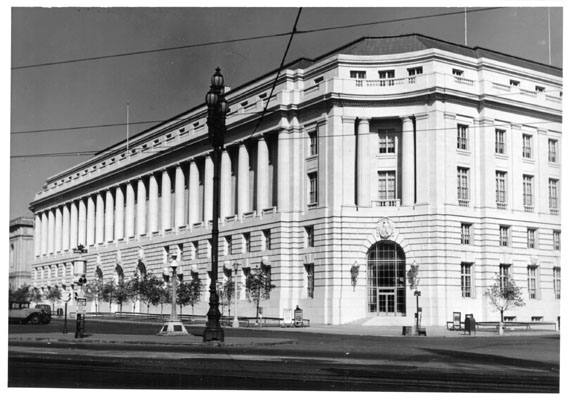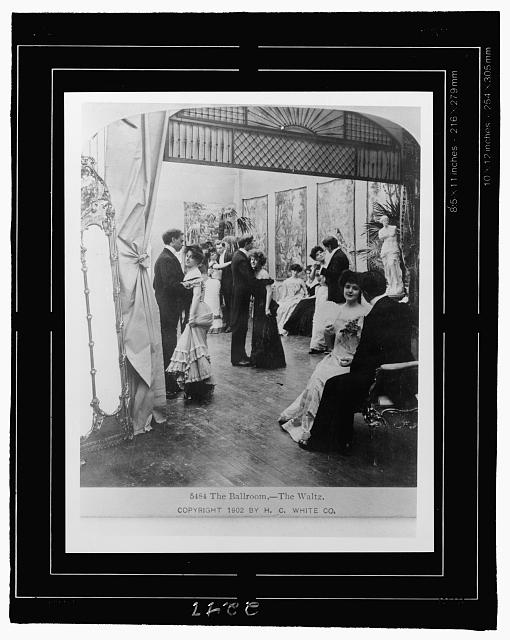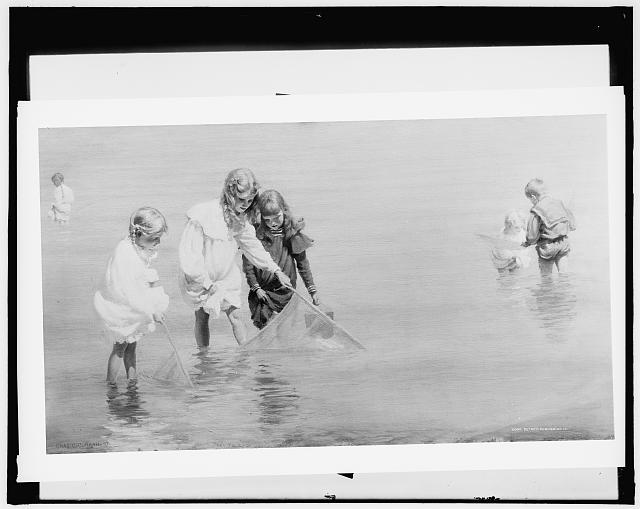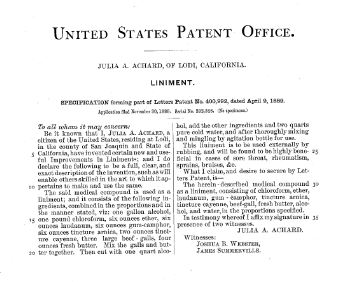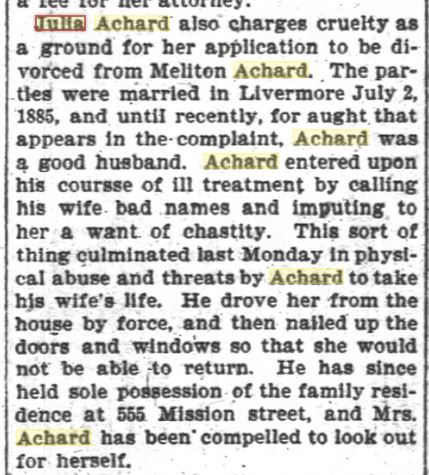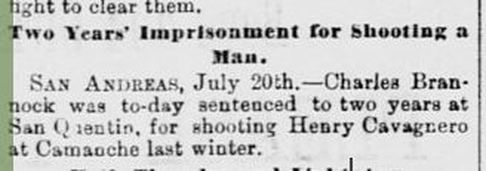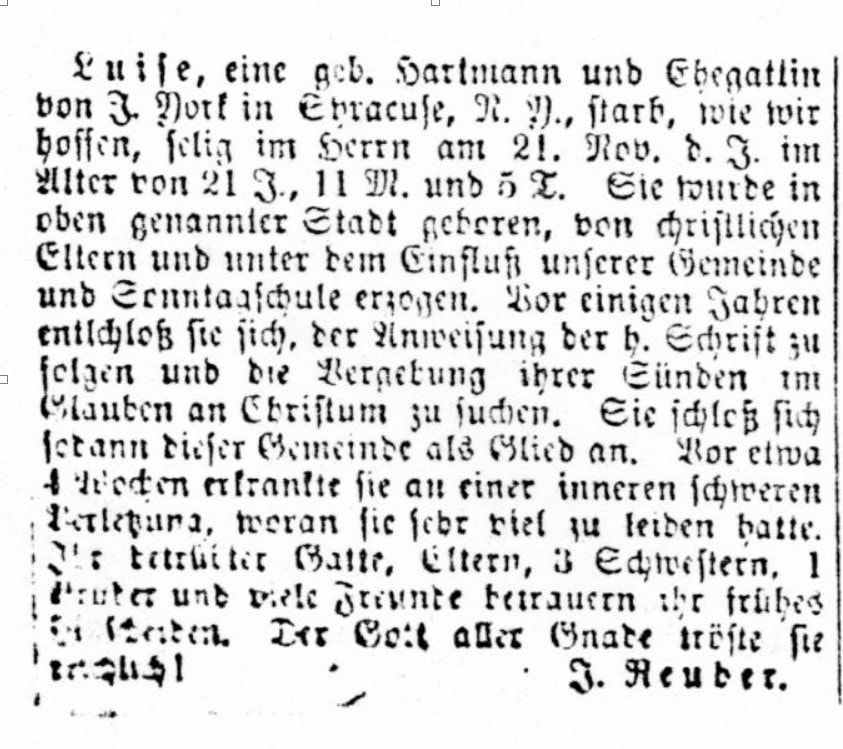 Undated newspaper clipping sent by my father's cousin Thelma VanAlstyne with Kircher and Springer family papers Undated newspaper clipping sent by my father's cousin Thelma VanAlstyne with Kircher and Springer family papers I had the most wonderful experience yesterday at the Virtual Genealogical Association’s conference. I’ve been fortunate in the last five years or so to be selected to present at conferences and to genealogy societies about my favorite topic. I’ve gotten to meet some very nice people. I’ve learned more about my own family as I’ve tried to come up with examples to demonstrate a technique or website. I’ve made a little bit of money to spend on my genealogical addiction. But my favorite part is having a captive audience who might have an answer to one of my own questions. Yesterday I presented “Fraktur und Fremdwörter: Hacks for Reading Foreign Books & Newspapers” at the VGA conference. I had a chance to demonstrate how a hopelessly English-only reader can find an old German fraktur font newspaper article about their ancestor and easily, painlessly, and in only a few minutes, translate it into something they can read. I demonstrated the how-tos for all my favorite newspaper sites. In addition to finding newspaper articles on websites, I think genealogists often have snippets of things in their family papers – perhaps an article pasted into a scrapbook. I have one such article from my Dad’s cousin Thelma with the notation “Translation? Appears it concerns Louise Hartman, Syracuse, N.Y.” I played around with finding a way to scan that article and convert it to OCR. None were terribly effective. In my presentation, I showed my unsuccessful attempts with the caveat, “Sorry folks, on this kind of an item, you just might need to buck up and try to transcribe that article yourself. Unless…. If anyone knows some better way, I’d love to hear about it.” And in that captive audience, Mr. Miles Meyer piped up (in the chat box) and suggested NewOCR.com. From their website: NewOCR is a ”free online OCR (Optical Character Recognition) service, can analyze the text in any image file that you upload, and then convert the text from the image into text that you can easily edit on your computer.” I’ll post again in the next few days about my attempts to transcribe my scrapbook article with my new-found tool. But in the meantime, thank you Miles, thank you Katherine Willson, Dan Earl, Linda Debe and the rest of the people at the Virtual Genealogical Association for putting on a great conference. If you’re interested, check them out. You might be able to be able to catch up on the recordings of the great sessions they have offered at their second virtual conference.
2 Comments
I recently stumbled upon a random newspaper article, “Deaths on the Plains this Season.”[1] Other than the title, the article provides little in the way of detail about why, or how, or from where came the list of names of 250 people who perished as they journeyed to a new life in the west. Nearly all the names are associated with a death date, such as “C.S. Carter, June 5.” Some, like “John Holeman, June 5, age 19” are accompanied by a bit more information, but with “Joseph Langley, age 47,” readers don’t know when he passed.
A man known only as “Battsford” died July 26, “shot by his captain.” T Miller, age 26, was murdered June 15 by R. Tate. But possibly Mr. Tate received his due – “Lafayette Tate, hung June 15, for murder of T. Miller.” M. J. Henderson died the same day. He was from Wisconsin, age 1 year, 2 months and 15 days. The Hardcastles were hit hard in their migration – W. C. died 16 August, age 23; R. P. died, 23 June, age 25; Mrs. D. A. Hardcastle died 6 June, age 26; J. M. Hardcastle died 7 June, age 6; and Mrs. D. J. Hardcastle died 16 June, age 25. Who were these people who shared a surname? Where were they from? Where did they hope to make their new home? A portion of names are associated with locations. Thomas H. Foster who died 18 May at age 25 hailed from Cumberland, Md. R. H. Nelson from Monroe, Michigan died 26 May at age 25. Illinois, Ohio, St. Louis, Pike county Mo., Harvard, Ind., Rarrington, Ohio, and Fairfield, Whoknowswhere all lost sons and daughters who once called those places home. When I first ran across the article I considered how many genealogists who’ve had ancestors “just disappear” have thought about searching newspapers in far-flung locations? Does anyone researching the Baxton family from Ohio City, Ohio wonder what became of G. C. Baxton, born about 1830? He died – somewhere on the plains – 24 June 1852.[2] I tried to find the back story on some of the faceless names from the column, searching 1850 census records to see if I could identify any of those who had a specific location and an age associate with their names. Sadly, I struck out on the handful I investigated. But a Google search led me to David J. Langum’s “Pioneer Justice on the Overland Trails” with more news about two of those 250 deaths in the 1852 newspaper - T. Miller’s and Lafayette Tate.[3] T. Miller, (unnamed in Langum’s article,) was a cattle overseer in the Brown emigrant party who fought with one of the drivers by the name of Tate. The driver's brother, Lafayette Tate, 19, ran up, stabbed Miller in the back, then slit his throat. Based on multiple diary accounts cited by Langum, we learn about the speedy frontier justice – with quickly assembled jury, judge, prosecutor and defense counsel. Witnesses were examined, Tate was found guilty and thirty minutes later hanged. According to the diaries Langum cited, the brother who originally fought with Miller was allowed to continue on with the company. For those interested in more about pioneer justice on the trails, be sure to read Langum’s article. But even for those whose relatives might have disappeared in a less dramatic fashion, I hope this post might inspire researchers to not stop at just the local paper in their ancestral locations, but consult even far-off papers for details on their families’ lives. [1] “Deaths on the Plains this Season,” Sacramento Daily Union, 2 November 1852, p. 2, col. 5; digital image, California Digital Newspaper Collection (www.cdnc.ucr.edu : accessed 7 July 2020). A search on The California Digital Newspaper Collection for “death on the plains” led to other articles in Sacramento and San Francisco newspapers, some of which were repeats of each other. [2] “Death on the Plains this Season.” [3] Langum, David J. "Pioneer Justice on the Overland Trails." The Western Historical Quarterly 5, no. 4 (1974): 421-39. Accessed July 7, 2020. doi:10.2307/967307. A few weeks ago I blogged about how to translate German newspapers on Newspapers.com. Today, someone on facebook asked a similar question, but her paper was on GenealogyBank. I knew enough to know that if you can type a name in the search box and get a hit, somewhere behind the scenes there must be a little squirrel in a cage who matches what you type with the OCR files. But where the heck is that squirrel hiding on GenealogyBank? So I asked… Yes, those live chat opportunities on your favorite websites can be a great source of info. I asked “Mike” at GenealogyBank and he didn’t know the answer, but got back to me a while later via email. And yes, it’s doable! Find the article you want on GenealogyBank. I’m using a German-language paper, because generally I can read the English ones, but I need help with the German ones. My target article is the one in the red box. I can read enough of the Fraktur font to know the first couple of words in my article are “John C Horstmann gestorben” and the last words are “Pastor Otto Buess amtirte.”[1] That will be important… Right click anywhere in that white header at the top where my red arrow is pointing. You’ll get the dropdown box shown. Click where it says “View page source.” Get ready, folks… it’s not pretty. You can see the little gray bar on the right, showing how long this page is. And the entire thing is filled with this little teeny tiny print. Ugh. But Ctrl+F is your friend. That will bring up a search box. Use that to search for one of the words in your article. I figured “John” was probably on the page a lot, “Christian” not so much, so I chose that. GenealogyBank highlighted all the instances of “Christian” in yellow, so it was pretty easy to spot the one I wanted. Interestingly, though the newspaper page is laid out in columns, the OCR goes article by article. (I haven’t experimented enough to know if this is always the case, but for this example it definitely worked. Fingers crossed for your searches.) So it was pretty easy to highlight the whole article I was looking for. (Remember where I told you above that knowing the first few and last few words of your article would be important? Now you know why!) I pasted that text into a Word document. I also put a clipping of the article in the Word document (as an image). When I click on the article image, Word brought up the Format tab. On that I clicked on the “Wrap Text” icon and selected “Tight.” This put the image and the copied text right next to each other. There were a few errors in the text, but surprisingly not as many as I anticipated. But with the article image and the text right next to each other, it took me a only few minutes to clean it up. Once I had what I thought was correct, I copied that and pasted it into GoogleTranslate (https://translate.google.com). And I had my translation! I know, I know, GoogleTranslate is not perfect, but it’s perfecter than I am with my rudimentary German skills. And it’s fast. I can quickly get the gist of the article and determine if it’s of interest. So that’s my quick trick today to translate those pesky funny-font foreign language newspapers. I hope it helps you discover more about the stories of your ancestors. [1] “John C. Horstmann gestorben,” Die Gasconade Zeitung (Herman, Missouri), 28 January 1921, p. 2, col. 4; digital image, GenealogyBank (https://www.genealogybank.com : accessed 8 April 2019). I recently posted about how to translate German books. Today I saw a post on the "German genealogy & cultural history" Facebook groupabout how to translate from Newspapers.com. I wanted to know, too, so I figured out a solution. It’s pretty simple. Find an article you would like to translate on Newspapers.com. Click on the “Clip” icon above the newspaper page and draw a box around the article you want to translate. After you’ve selected your text, click on the blue “Clip”. A window will pop-up prompting you to “Share” or “View Clipping”. Click on “View Clipping”. That will revise the view to show only the clipped portion. Notice underneath the article the words “Show article text (OCR)”. Click on that. Voila! the text magically appears. It is not perfect. I’m sure there are errors in this text. I can see an “i”, possibly because my clipping included the vertical lines on the left and right of the article. There could be other glitches, as there often are with Optical Character Recognition (OCR), depending on the quality of the image, but at least I have something. Now I can copy the transliterated text and paste it into GoogleTranslate. , GoogleTranslate is not perfect, either, but hopefully I can get the gist of the clipped article. If I want a better translation I can hire a translator to translate the original article. Pretty quickly I was able to be able to roughly “read” this foreign language article. What foreign language newspaper are you going to search first? Newspapers are possibly my favorite records. I can find many details of my ancestors’ lives. I recommend searching by name, of course. But have you thought about other ways to search? My new favorite way seems to be searching by location. I have relatives who moved from one small town in one state to another small town in another state. When I learned this, questions arose. Why? And more specifically, why that town? More questions – Did they ever go back home to visit or live? Did anyone from the home town visit them in the new place? And maybe, just maybe, you’ll find an article where the names were butchered, either by an author or typesetter spelling mistake, or an Optical Character Recognition (OCR) translation mistake. I recently searched in an Osage County, Kansas newspaper for “Webster, New York,” the hometown of several family members. And I found a perfectly readable (to the naked eye) article with perfect spellings of my relative’s name. It had never come up on a search by name. Here’s the article: It’s pretty easy to read the article. You can read the names, right? A. E. Billings. Anna Kircher.
But here is what the Optical Character Recognition (OCR) software “read.” “ Marmkd. At the Baptist church, in Webster, N. Y,, June 11th. by the Rev. E. F. Waine, Mr. A. E. Bili.ings, of Burlingame, Kansa, to Miss Axxa Kirches, of Webster, New York. We heartily wish our iViend Asa and his fair young bride long life and a world of happiness, contentment and prosperty.” I’ve shown in red the OCR mistakes, and in green the one word misspelled in the newspaper, (not an OCR mistake). The surnames of both bride and groom were misread by OCR. I never would have found this record, never would have known about this marriage, if I had not searched by place. Next time you search in online newspapers, try searching by place. Who knows what you’ll dig up. 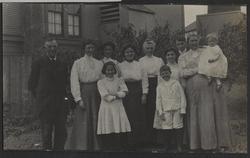 The Bradley Family in Tiburon, California, circa 1910. Back row, left to right, Patrick Thomas Bradley, Agnes Bradley Kircher, Lizzie Bradley, Kathryn Frances Murphy, Catherine Bradley Murphy, Rosella Graham, Hilary Bradley, Mary Agnes Ahern Bradley, Mary Frances Kircher. Front row: Miriam "Brownie" Bradley, Graham Bradley The Bradley Family in Tiburon, California, circa 1910. Back row, left to right, Patrick Thomas Bradley, Agnes Bradley Kircher, Lizzie Bradley, Kathryn Frances Murphy, Catherine Bradley Murphy, Rosella Graham, Hilary Bradley, Mary Agnes Ahern Bradley, Mary Frances Kircher. Front row: Miriam "Brownie" Bradley, Graham Bradley “Miss Rosella Graham, daughter of A. D. Graham of El Verano, was run down by a team of horses Tuesday while riding a bicycle. She is still suffering for the effects of the injuries, which will not prove fatal.”[1] Thank goodness those injuries did not prove fatal. Rosella, was my great aunt, and I have fond childhood memories of all 4’11” of this little old lady. She joined the Bradley family when she married my grandmother’s brother, Hilary Bradley, in 1913. Rose died in 1985, somewhere in her mid- to late-90s. It’s not clear exactly how old she was, because when she married Hilary, she was at least a few years older than he. She didn’t want anyone to know, so she burned, buried or otherwise destroyed any evidence, lying about her age… until she hit 90, when it because something of a status symbol to have lived so long. By then she wanted to take full advantage of the respect accorded to such a venerable character and she raised her age by 2 (or 3) years between the birthday celebrations. I’m visiting California for “The Bradley Picnic,” a reunion of the Bradley family. I came a few days early and my dear sister, Diane, who knows how passionate I am about my genealogy, offered to drop me off at the Santa Rosa library while she ran some errands. Talk about hog heaven! And scrolling through newspapers, I found the above article about the bicycle and the horses. At our picnic yesterday, I mentioned it to Rose’s granddaughter and her husband, Mary and Len. Mary recalled the story, remembering seeing evidence of the injury years later, a “hole” in Rose’s thigh that never quite healed. The story as Mary recalled was that Rose was hit by a car, not a team of horses. Rose never placed any blame on the driver, saying it was her own fault for riding into the road right in front of the vehicle. But the cool part of the story was the identity of the driver. Not mentioned in the newspaper, but according to Rose (well Mary’s recollection of what Rose told her), it was none other than Jack London. Rose reported that Jack London had the first automobile in Sonoma. After the party ended, I spent a little time trying to research this. Could it have been Jack London? He certainly was in town that week, and he loved his horses. The Press Democrat from 9 June 1905, reported that London had recently ridden from Sonoma to Santa Rosa to see his good friend, Luther Burbank. “Frequently during the last two or three months, Mr. London and Miss Kittredge have enjoyed horseback rides all over the Sonoma Valley and to Santa Rosa, Altruria and other places. Both are passionately fond of horseback riding.”[2] A few years later he spoke about his Sonoma farm to a reporter for the Sacramento Union, “’I’ve the finest lot of horses over there you’d see anywhere… just see’ – he rolled up the sleeve of his right arm and proudly exhibited a rigid muscle – ‘got that from driving a four-horse team. I’ve sailed a bit in my time and done other hard work, but I never developed that muscle until I took to driving. It’s great.’”[3] I searched the newspapers to see if I could confirm a story about London owning an automobile but I found nothing. A man of his means could very well have had the first auto in the town. Maybe London was driving an auto and spooked a horse-drawn wagon causing the collision with Rosella. But it’s also clear London enjoyed driving a team of horses. So maybe Rose did collide with Jack. And knowing me, this is probably not the end of my research into this story. I’ll keep you posted. I’m sure glad I found that article about Rose and the bicycle just in time for the Bradley picnic and the opportunity to hear a bit more about it from her granddaughter. Do you have a family story about a celebrity? Have you proved it or disproved it? Feel free to post a comment below and tell me your story. [1] Petaluma Morning Courier, 3 June 1905, page 4, col. 3 [2] Press Democrat, 9 June 1905, page 7, col. 2 [3] “Jack London Fulfills His Youthful Vows With Sutter Fort Pilgrimage,” Sacramento Union, 9 December 1912, page 1 col 5 and page 3 col. 5 On Sunday I posted a transcription of a letter my uncle wrote to my grandparents on 8 July 1942 describing leaving his home in San Francisco and traveling to Navy boot camp in San Diego.
When you are reading and sharing your family letters, it will be a much richer experience if you take the time to understand the context in which the letter was written. Here are some ideas to get you started in researching the context. Look for images. Warren mentioned several places in his letter, among them the Federal Building in San Francisco and the Santa Fe railroad depot in Los Angeles. I was able to do image searches on google and find historical photos of those buildings. Libraries and state archives are another good resource for finding vintage images of buildings. With these searches I was able to go back in time and see what my uncle saw. I knew that Warren was in the navy, and I was able to use Fold3 to discover a bit more about his experience. A 31 December 1943 muster roll from the submarine Searaven showed an enlistment date of 6 July 1942, just two days before he wrote the letter. That immediately got me thinking about what my 21-year-old uncle might have been feeling – excitement, fear, homesickness and more. I thought about the date. July 6 was a Monday. Just two days after Independence Day, the most patriotic of holidays. I imagine the first 4th of July after Pearl Harbor must have held some particularly impassioned celebrations. Might those have perhaps prompted Warren to enlist? What was going on in San Francisco and the world at that time? I looked at the San Francisco Chronicle and found some answers. On Sunday 5 July 1945, page 1 of the comics ran the cartoon, “Terry and the Pirates.” In this strip, the evil Chinese captor threatens Muzz and derides her independence. Mazz ponders the words of the Declaration of Independence regarding the inalienable rights of life, liberty and the pursuit of happiness and how we must invest in our futures to keep those rights. Elsewhere in the same paper, above the masthead on page 1 of the news section, was a striking photograph, the full width of the page, captioned “Yesterday, San Francisco saw a parade. San Francisco has seen other parades, many of them, but never one like this. For passing grimly down Market street marched sudden death. This was typified by a 3200-man combat team of the Army of the United States. Armed to the teeth, this unit, however, was not unique. It was only representative of hundreds of other such units in the United States and over the world ready – and anxious – for a scrap. Above, infantrymen of the unit march by with fixed baoynets.”[i] Other page 1 stories included “New Zealanders Pile Into Rommell; The Tide MAY Be Turning in Battle of Egypt,” “First Yank Flyers Skim Dutch Housetops to Bomb 3 Airdromes in Nazi Europe” and more.[ii] It seems that every day the first several pages of the Chronicle were filled with accounts of the war. Warren must have had those stories in his mind when he enlisted and as he wrote his parents of his experiences as a new recruit. When you’re reading old correspondence, make sure you spend some time studying the history, reading the local newspapers of the time, and finding images to make your family letters and the people who wrote them come alive. [i] San Francisco Chronicle, 5 July 1942, page 1, col 1. [ii] San Francisco Chronicle, 5 July 1942, page 1 Last week saw the “final” blog post on the always-fascinating Julia Achard. (Final???!!! Don’t you believe it! I doubt I’ll ever be done with my obsession with her exploits.) But...as I search for more stories of my ancestors, their families, friends, associates, neighbors, and those random people I find mention of in old newspapers to share on the blog, let me report on a picturesque incident – a cautionary tale for beachcombers and fisherfolk even today. Before I wrapped up my Julia saga, I just had to do one more newspaper search and I found a brief mention of her in the Berkeley Daily Gazette of July 26, 1909. “Miss D. Wright and Mrs. J. A. Achard will open a dancing academy, Native Sons’ hall, Saturday evening, July 31st at 8:30. Juvenile class Wednesday, August 4th, at 2:30. Ballroom, fancy and stage dancing, physical and grace culture. Songs with gestures taught by the quickest methods.”[i] Gotta hand it to Julia, at nearly 70 years old, she’s opening a dancing academy. Quite a go-getter. I need to see if I can find out a bit more about Miss D. Wright, but newspaper-rubbernecker that I am, I was captivated by many stories on that page, (a bigamist!, an embezzler! a leather dog-valise!), none so much as the tale of poor little Millicent Leary. “Timidly knocking at the door of the emergency hospital, two little girls appealed to the matron for aid. One of the youngsters was holding a blood-soaked handkerchief to her nose. ‘The crab did it – the nasty thing,’ sobbed the poor sufferer. ‘I’m not going to fish any more. It hurts my nose.’”[ii] It seems Millicent and her friend caught two small crabs and put them in a box. Curious Millicent insisted on peeking in the box at the angry crustaceans, one of whom showed his displeasure by pinching her on the nose. The doctor and nurses fixed her up and she was able to go home, a bit wiser for the experience. Next time you go beachcombing, picture Millicent and remember to keep your schnozzle a safe distance from the crabs! [i] Berkeley Daily Gazette, 26 July 1909, page 5, col 2 untitled article, from California Digital Newspaper Collection, cndc.ucr.edu : accessed 12 March 2017. [ii] Berkeley Daily Gazette, 26 July 1909, page 5, col 3 “Crab Bites Little Girl on the Nose,” from California Digital Newspaper Collection, c Last week we left off with Julia's brother, Charles Brannack, arrested in the opium dens of Santa Cruz. Today we return to Julia's saga... By the time Charles Brannack was arrested in Santa Cruz, his sister had been married to her third husband, Meliton Achard, a Frenchman, and at last a husband near to her own age. They were wed 2 July 1885 in Livermore, California.[i] For a time they lived in Lodi. This may be where Julia began her occupation as a midwife. On 30 November 1889 Julia filed a patent application for a liniment, “highly beneficial in cases of sore throat, rheumatism, sprains, bruises, &c.” It’s ingredients were specified as one gallon alcohol, one pound of chloroform, six ounces ether, six ounces laudanum, six ounces gum-camphor, six ounces tincture arnica, two ounces tincture cayenne, three large beef-galls, four ounces fresh butter.[ii] She advertised her compound in various newspapers.[iii] Julia and Meliton lived for a time in Lodi and then moved to San Francisco. She advertised herself as a midwife and Meliton is listed in the city directories as a hotel keeper, The Liberty House.[iv] It is hard to know how long they lived happily together, but the end of the marriage appears decidedly unhappy. "Julia Achard… charges cruelty as a ground for her application to be divorced from Meliton Achard. The parties were married in Livermore July 2, 1885, and until recently, for aught that appears in the complaint, Achard was a good husband. Achard entered upon his course of ill treatment by calling his wife bad names and imputing to her a want of chastity. This sort of thing culminated last Monday in physical abuse and threats by Achard to take his wife's life. He drove her from the house by force, and then nailed up the doors and windows so that she would not be able to return. He has since held sole possession of the family residence at 555 [sic] Mission street, and Mrs. Achard has been compelled to look out for herself.[v] Much as this would lead one to believe that Meliton no longer loved Julia, apparently he (or perhaps Julia) had a change of heart . Seven months after his incident with the hammer and nails, Meliton’s obituary reads, “Died… Achard, In the Napa Insane Asylum, 9 July 1896, Meliton Achard, beloved husband of Julia A. Achard, a native of France, aged 52 years, 3 months and 29 days.”[vi] Julia was not widowed for long. On 12 June 1897 she married her fourth husband, Edward W. Matthews in Oakland.[vii] But this turn at married life proved no happier for Julia, and she was granted a divorce from Edward on 9 January 1899 on the grounds of neglect.[viii] Julia lived in San Francisco for several years as a “widow.” She appears to have used the surname Achard, at least professionally, for most of the remainder of her life. In June of 1898 she was practicing as a midwife with a “home in confinement” at 126 Second street.[ix] Perhaps one such patient of Julia was Rose de la Fontaine. Rose, the daughter of Edward and Mary O’Neill was born about 1874.[x] On 22 February 1893, Rose married John de la Fontaine.[xi] Five months later Rose gave birth to Florence, who sadly died on 31 August 1894 at the age of one year, one month and one day.[xii] On 22 January 1899, John and Rose lost another child, Grace, at the age of two months and 16 days.[xiii] Maybe Julia Achard assisted at the birth of Grace. In any event, in September of 1899, Rose was under the care of Julia Achard, when she died on 8 September. “It was reported to Coroner Hill that Mrs. Achard had represented herself to be a physician. Should this prove the fact, the woman will be liable to prosecution for practicing medicine without a license. Malpractice is suspected.”[xiv] However, the following week, the newspaper headline indicated “Midwife Achard was not to blame at all, Mrs. de la Fontaine died of a painful disease. First Verdict of the Jury not approved and a second verdict of death from natural causes received. Coroner Hill held an inquest yesterday morning upon the body of Mrs. R. de la Fontaine… The deceased had been attended by Mrs. Achard, a midwife, who had administered some simple remedy to relieve vomiting. The autopsy showed that cirrhosis of the liver had caused death and that there were no evidences of malpractice or of even any necessity for it. Mrs. Achard testified that in her experience of thirty-eight years as a midwife Mrs. de la Fontaine was the only patient who had died in her care. She had suggested that a physician should be called, but Mrs. De la Fontaine refused to allow one to be summoned, as she did not believe her condition to be serious. The jury returned a verdict that death had been caused by neglect, on the part of some person unknown, to summon medical assistance, but the coroner refused to approve of the verdict and the case was reopened and additional evidence introduced. Autopsy Surgeon Zabala assured the jury that death was due to disease and even if a physician had been called in a few days before her death it was doubtful whether he could have succeeded in saving her life. The jury returned a verdict of death from natural causes, and the verdict was approved".[xv] If Rose de la Fontaine was the first patient who died in the care of Julia Achard, she was not the last. [i] San Francisco Chronicle, 6 Dec 1895, page 8, column 5, “Cruel Husbands Sued for Divorce” [ii] Website: Women Inventor’s Index – 1790-1895, http://staff.lib.muohio.edu/shocker/govlaw/FemInv/patgifs/400992/01.jpg accessed 11 April 2013 [iii] Sacramento Daily Union, 22 Feb 1889, page 2, Advertisement “J.A.A. Liniment” [iv] Great Register of Voters San Joaquin County, California 1890 California State Library, California History Section; Great Registers, 1866-1898; Collection Number: 4 - 2A; CSL Roll Number: 119; FHL Roll Number: 977281; City Directories for San Francisco, California, 1892, Publisher: Edward M Adams, Page Number: 163 [v] San Francisco Chronicle, 6 Dec 1895, page 8, column 5, "Cruel Husbands Sued for Divorce" (note: city directories of the period indicate the address of the Achards was 550 Mission, not 555 Mission as stated in the newspaper article) [vi] San Francisco Call, 17 July 1896, page 13 [vii] San Francisco Chronicle, 14 June 1897, page 9, column 3. [viii] San Francisco Chronicle, 10 January 1899, page 6, column 1. [ix] San Francisco Call, 2 June 1898, page 10 [x] US Census 1880 Year: 1880; Census Place: San Francisco, San Francisco, California; Roll: 77; Family History Film: 1254077; Page: 74C; Enumeration District: 151; Image: 0150, lines 6-15, accessed through Ancestry.com 5 March 2013 [xi] San Francisco Call, 20 July 1893 (sic), page 12, “Married” (note spelling is listed as de la Fontane) [xii] Ibid, 1 September 1894, page 8, “Deaths” [xiii] Ibid, 23 January 1899, page 9, “Deaths” [xiv] San Francisco Chronicle, 9 September 1899, page 11 “Malpractice Is Suspected” [xv] San Francisco Call, 12 September 1899, page 12, “Midwife Achard Was Not To Blame At All” It would be difficult to assess who was the blackest sheep in the Brannack fold, but Julia’s brother, Charles Edgar Brannack might be a good candidate.
In January 1882, Charles and his nephew, Fred Wermuth (the two of them only a year apart in age) were involved in a barroom brawl in Calaveras County. Charles and Fred along with their friends, a pair of cousins named Thomas and Robert Pope had gone quail hunting. The four men, none older than 23, packed their hunting gear, including four shotguns, and camped in a deserted cabin in the Sierra foothills. On Friday evening they traveled to the town of Camanche, and after a period of drinking in John Cavagnero’s general store, they got into a row with each other, breaking up furniture, glassware and windows. Henry Cavagnero, John’s brother[1], sent word to John who came in, calmed the men down and got them out into the street. Back inside, the Cavagnero’s heard someone in the street yell, “Look, he’s going to shoot!” whereupon Charles Brannack rushed back inside, leveled his shotgun at Henry and exclaimed, “Shall I shoot the son of a bitch?” And he did! Cavagnero was seriously injured, shot entering in his head and neck. Another man standing by him, Michael Fox, was also struck with shot in his nose.[2] The four ruffians took off in a wagon at break-neck speed, headed for Lodi. The wagon hit a stump, threw some of the men and some of the shotguns which fired as they hit the ground. The Pope cousins, one of whom was wounded on his head, turned themselves in the next morning, but were later discharged. Charles Brannack was arrested and jailed in Sacramento, though no charges were brought against Fred Wermuth.[3] In July, Brannack was sentenced to two years imprisonment at San Quentin prison for shooting Cavagnero.[4] It appears Henry Cavagnero survived.[5] Any time he may have served in prison did little to improve Charles Brannack’s behavior. In November 1887, the Santa Cruz police chief and another officer witnessed a man purchase opium. The two followed him, trying to find his “joint” – the place where he would smoke the entrancing drug. They followed him to Lyman Brannack’s barn . The officers saw a light in the upper part of the barn. Stepping to the door, the officers were confronted by Charles Brannack, the son of the owner, carrying a lantern in one hand and a shotgun in the other. Seeing the officers, Brannack blew out the light. They seized Brannack, and upstairs in the barn found there a regular opium joint. They arrested Brannack and confiscated all the paraphernalia.[6] Charles Brannack and fellow smoker, Henry Horn, were brought before Justice Skirm, who fined Brannack $100 and Horn $25, and while Brannack was able to pay his fine, Horn could not and was sentenced to $25 in jail.[7] By the time Charles Brannack was arrested in Santa Cruz, his sister had been married to her third husband, Meliton Achard, a Frenchman, and at last a husband near to her own age…. More next week about Julia’s marriage to Mr. Achard. [1] It appears that Henry Cavagnero was likely John Cavagnero’s brother-in-law per the 1900 census. - US Census 1900 Year: 1900; Census Place: Jenny Lind, Calaveras, California; Roll: 84; Family History Film: 1240084; Page: 6A; Enumeration District: 1038; lines 36-43, accessed through Ancestry.com 29 January 2017 [2] San Francisco Chronicle, 22 Jan 1882, page 8 “A Barroom Brawl” and Sacramento Daily Union, 23 Jan 1882, page 1, “Result of a Carouse” [3] ibid [4] San Francisco Bulletin, 22 July 1882, page 2, “State News Items” [5] US Census 1900 Year: 1900; Census Place: Jenny Lind, Calaveras, California; Roll: 84; Family History Film: 1240084; Page: 6A; Enumeration District: 1038; lines 36-43, accessed through Ancestry.com 29 January 2017 [6] Santa Cruz Daily Surf, 5 November 1887, page 1, col 5. “Opium Smokers Arrested” [7]“Sentinel Jottings,” Santa Cruz Sentinel (Santa Cruz, California) 06 Nov 1887, Page 3, col 1, accessed through Newsapapers.com 29 January 2017 |
AuthorMary Kircher Roddy is a genealogist, writer and lecturer, always looking for the story. Her blog is a combination of the stories she has found and the tools she used to find them. Archives
April 2021
Categories
All
|
